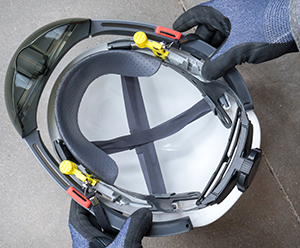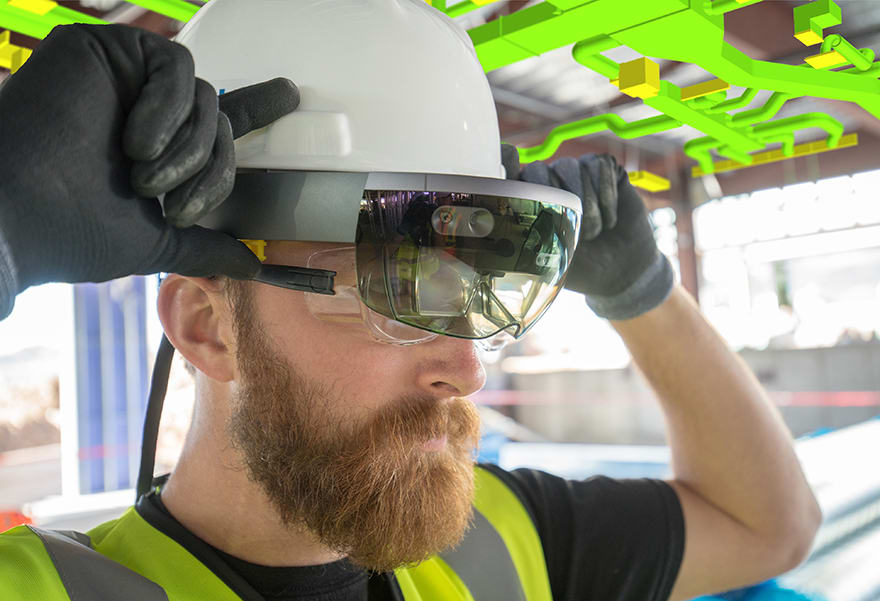A low-cost adaptation for hard hats could drive the widespread use of augmented reality on construction sites.
GPS expert Trimble has worked with Microsoft to develop the innovation, which is designed to integrate the HoloLens holographic computer with an industry-standard hard hat.
The accessory, fitted with a suspension mechanism, attaches the HoloLens to connections on a MSA V-Gard hard hat, replacing the conventional “inner ring” of the HoloLens that clamps it to the user’s head.
The hard hat and the accessory sell for $300 (£217), which with the current £2,719 cost of purchasing a developer edition of HoloLens, means contractors can bring augmented reality into the field for under £3,000.
The need for 3D visualisation outside the office and the need to meet safety regulations was a driving force behind the innovation, says Aviad Almagor, director of the Mixed Reality Program at Trimble: “Many existing customers of our software for HoloLens, had a requirement to comply with safety regulations, this innovation extends the benefits of HoloLens into areas where increased requirements are mandated, such as construction sites, offshore facilities and mining projects.”

The accessory is fitted with a suspension mechanism and fits inside the hard hat
The system is currently approved for use by the American National Standards Institute (ANSI).
Almagor says Trimble has received a “significant number of orders” for the hard hats that will go to a mix of general contractors, MEP contractors, architects and others in countries worldwide.
The hard hat is able to run any software for HoloLens, including Trimble’s new mixed reality application Trimble Connect, which aligns holographic data on a 1:1 scale on the job site. This enables users to review models in the context of the physical environment. Mixed reality is a form of AR that augments the real world with virtual objects that look as if they are really there.
The software is able to display 3D models of structure and mechanical and electrical systems overlaid on top of actual work being completed on site to help improve design coordination and spot inconsistencies and clashes. Users can view assigned tasks and capture data using onsite measurement tools, it is also being used for training.
Early adopters of the hard hat have included French contractor GA Smart Buildings, which used the system on site for MEP quality control, and for comparing actual work to the 3D design model to identify any discrepancies. LMP, one of largest construction companies in India, is using it to train onsite teams in work procedures and to carry out quality control.

Contractors can bring augmented reality into the field for under £3,000
The official launch was greeted with enthusiasm by Kazendi, a developer of commercial mixed reality applications for HoloLens. In a blog post it said: “We are excited by the news that with this add-on HoloLens will finally be industry compliant for use in hard hat zones.
“This addition gives further scope to the usage of HoloMeetings, designed to transform the way corporations communicate, collaborate and expedite their processes, bringing the conversation to the frontline where the constructor, architect and planner can all be present.”
A key selling point of HoloLens is that it runs on Windows 10 infrastructure, which means multiple applications for different industry use can be run on the same device.
Critics of augmented reality have highlighted the potential for the technology to distract users’ attention from various hazards on site, resulting in accidents or injuries.
Almagor says such concerns are unjustified: “Although users need to be aware of the risks associated with wearing the device, I don’t see a big difference between this system and using a phone or a tablet in the field,” he says. “And because you are looking through HoloLens it is not blocking your view to the same extent. It’s really about being aware that the technology attracts your attention and being cautious about what is going on around you.”
HoloLens can also be easily removed using quick-release clips on the accessory, leaving the hard hat in place.











